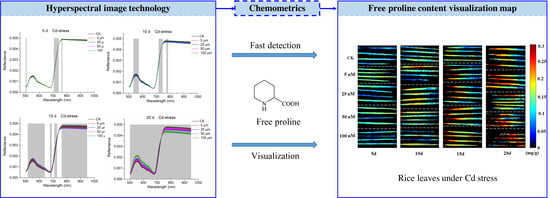High-Throughput Screening of Free Proline Content in Rice Leaf under Cadmium Stress Using Hyperspectral Imaging with Chemometrics
Abstract
1. Introduction
2. Materials and Methods
2.1. Rice Leaf Samples
2.2. Hyperspectral Image Acquisition and Correction
2.3. Gold Standard Methods for Measuring Leaf Contents of FP
2.4. Data Analysis
2.4.1. Variable Screening Methods
2.4.2. Quantitative Analysis Methods
2.5. Software and Model Evaluation
3. Results
3.1. FP Content of Rice Leaves
3.2. Spectra Analysis
3.3. Quantitative Analysis Based on Full Spectra
3.4. Quantitative Analysis Based on Selected Variables
3.5. Visual Analysis of FP
4. Discussion
4.1. Influence of Cd Stresses on Rice Leaves
4.2. Advantages of Hyperspectral Imaging
4.3. Prediction Models
5. Conclusions
Author Contributions
Funding
Acknowledgments
Conflicts of Interest
References
- Fukuoka, S.; Saka, N.; Koga, H.; Ono, K.; Shimizu, T.; Ebana, K.; Hayashi, N.; Takahashi, A.; Hirochika, H.; Okuno, K. Loss of function of a proline-containing protein confers durable disease resistance in rice. Science 2009, 325, 998–1001. [Google Scholar] [CrossRef] [PubMed]
- Ashraf, M.; Foolad, M.R. Roles of glycine betaine and proline in improving plant abiotic stress resistance. Environ. Exp. Bot. 2007, 59, 206–216. [Google Scholar] [CrossRef]
- Singh, M.; Pratap Singh, V.; Dubey, G.; Mohan Prasad, S. Exogenous proline application ameliorates toxic effects of arsenate in Solanum melongena L. seedlings. Ecotoxicol. Environ. Saf. 2015, 117, 164–173. [Google Scholar] [CrossRef]
- Choudhary, M.; Jetley, U.K.; Abash Khan, M.; Zutshi, S.; Fatma, T. Effect of heavy metal stress on proline, malondialdehyde, and superoxide dismutase activity in the cyanobacterium Spirulina platensis-S5. Ecotoxicol. Environ. Saf. 2007, 66, 204–209. [Google Scholar] [CrossRef] [PubMed]
- Chen, C.T.; Chen, T.H.; Lo, K.F.; Chiu, C.Y. Effects of proline on copper transport in rice seedlings under excess copper stress. Plant Sci. 2004, 166, 103–111. [Google Scholar] [CrossRef]
- Zouari, M.; Ben Ahmed, C.; Elloumi, N.; Bellassoued, K.; Delmail, D.; Labrousse, P.; Ben Abdallah, F.; Ben Rouina, B. Impact of proline application on cadmium accumulation, mineral nutrition and enzymatic antioxidant defense system of Olea europaea L. cv Chemlali exposed to cadmium stress. Ecotoxicol. Environ. Saf. 2016, 128, 195–205. [Google Scholar] [CrossRef]
- Silva-Perez, V.; Molero, G.; Serbin, S.P.; Condon, A.G.; Reynolds, M.P.; Furbank, R.T.; Evans, J.R. Hyperspectral reflectance as a tool to measure biochemical and physiological traits in wheat. J. Exp. Bot. 2018, 69, 483–496. [Google Scholar] [CrossRef]
- Bolger, M.; Schwacke, R.; Gundlach, H.; Schmutzer, T.; Chen, J.; Arend, D.; Oppermann, M.; Weise, S.; Lange, M.; Fiorani, F.; et al. From plant genomes to phenotypes. J. Biotechnol. 2017, 261, 46–52. [Google Scholar] [CrossRef]
- Mishra, P.; Asaari, M.S.M.; Herrero-Langreo, A.; Lohumi, S.; Diezma, B.; Scheunders, P. Close range hyperspectral imaging of plants: A review. Biosyst. Eng. 2017, 164, 49–67. [Google Scholar] [CrossRef]
- Kiani, S.; Van Ruth, S.M.; Minaei, S.; Ghasemi-Varnamkhasti, M. Hyperspectral imaging, a non-destructive technique in medicinal and aromatic plant products industry: Current status and potential future applications. Comput. Electron. Agric. 2018, 152, 9–18. [Google Scholar] [CrossRef]
- Behmann, J.; Mahlein, A.K.; Paulus, S.; Kuhlmann, H.; Oerke, E.C.; Plümer, L. Calibration of hyperspectral close-range pushbroom cameras for plant phenotyping. ISPRS J. Photogramm. Remote Sens. 2015, 106, 172–182. [Google Scholar] [CrossRef]
- Golhani, K.; Balasundram, S.K.; Vadamalai, G.; Pradhan, B. A review of neural networks in plant disease detection using hyperspectral data. Inf. Process. Agric. 2018, 5, 354–371. [Google Scholar] [CrossRef]
- Kong, W.W.; Liu, F.; Zhang, C.; Zhang, J.F.; Feng, H.L. Non-destructive determination of Malondialdehyde (MDA) distribution in oilseed rape leaves by laboratory scale NIR hyperspectral imaging. Sci. Rep. 2016, 6, 8. [Google Scholar] [CrossRef] [PubMed]
- Zhang, C.; Liu, F.; Kong, W.W.; Cui, P.; He, Y.; Zhou, W.J. Estimation and visualization of soluble sugar content in oilseed rape leaves using hyperspectral imaging. Trans. ASABE 2016, 59, 1499–1505. [Google Scholar] [CrossRef]
- Kong, W.W.; Zhang, C.; Huang, W.; Liu, F.; He, Y. Application of hyperspectral imaging to detect sclerotinia sclerotiorum on oilseed rape stems. Sensors 2018, 18, 123. [Google Scholar] [CrossRef]
- Bates, L.S.; Waldren, R.P.; Teare, I.D. Rapid determination of free proline for water-stress studies. Plant Soil 1973, 39, 205–207. [Google Scholar] [CrossRef]
- Zou, X.H.; Hao, Z.Q.; Yi, R.X.; Guo, L.B.; Lu, Y.F. Quantitative analysis of soil by laser-induced breakdown spectroscopy using genetic algorithm-partial least squares. Chin. J. Anal. Chem. 2015, 43, 181–186. [Google Scholar]
- Jong, S.D. Regression coefficients in multilinear PLS. J. Chemom. 1998, 12, 77–81. [Google Scholar] [CrossRef]
- He, J.; Zhang, C.; He, Y. Application of near-infrared hyperspectral imaging to detect sulfur dioxide residual in the Fritillaria thunbergii bulbus treated by sulfur fumigation. Appl. Sci. 2017, 7, 77. [Google Scholar] [CrossRef]
- Kong, W.; Chu, Z.; Feng, C.; Fei, L.; Luo, S.; Yu, T.; Yong, H. Detection of sclerotinia stem rot on oilseed rape (Brassica napus L.) leaves using hyperspectral imaging. Sensors 2018, 18, 1764. [Google Scholar] [CrossRef]
- Sampson, P.; Bookstein, F. Partial least squares. Encycl. Stat. Behav. Sci. 2005, 3, 1523–1529. [Google Scholar] [CrossRef]
- Peng, J.; Liu, F.; Zhou, F.; Song, K.; Zhang, C.; Ye, L.; He, Y. Challenging applications for multi-element analysis by laser-induced breakdown spectroscopy in agriculture: A. review. TrAC Trends Anal. Chem. 2016, 85, 260–272. [Google Scholar] [CrossRef]
- Geladi, P.; Kowalski, B.R. Partial least-squares regression: A tutorial. Anal. Chim. Acta 1986, 185, 1–17. [Google Scholar] [CrossRef]
- Peng, J.; He, Y.; Zhao, Z.; Jiang, J.; Zhou, F.; Liu, F.; Shen, T. Fast visualization of distribution of chromium in rice leaves by re-heating dual-pulse laser-induced breakdown spectroscopy and chemometric methods. Environ. Pollut. 2019, 252, 1125–1132. [Google Scholar] [CrossRef]
- Suykens, J.A.K.; Gestel, T.V.; Brabanter, J.D.; Moor, B.D.; Vandewalle, J. Least squares support vector machines. 2002. [Google Scholar] [CrossRef]
- Coen, T.; Saeys, W.; Ramon, H.; Baerdemaeker, J.D. Optimizing the tuning parameters of least squares support vector machines regression for NIR spectra. J. Chemometr. 2007, 20, 184–192. [Google Scholar] [CrossRef]
- Steinwart, I.; Christmann, A. Support vector machines. Inf. Sci. Stat. 2008, 158, 1–28. [Google Scholar] [CrossRef]
- Huang, G.B.; Zhu, Q.Y.; Siew, C.K. Extreme learning machine: Theory and applications. Neurocomputing 2006, 70, 489–501. [Google Scholar] [CrossRef]
- Huang, G.B.; Zhu, Q.Y.; Siew, C.K. Extreme learning machine: A new learning scheme of feedforward neural networks. In Proceedings of the 2004 IEEE International Joint Conference on Neural Networks, Budapest, Hungary, 25–29 July 2004. [Google Scholar] [CrossRef]
- Shi, J.; Zhang, F.; Wu, S.; Guo, Z.; Huang, X.; Hu, X.; Holmes, M.; Zou, X. Noise-free microbial colony counting method based on hyperspectral features of agar plates. Food Chem. 2019, 274, 925–932. [Google Scholar] [CrossRef]
- Schat, H.; Sharma, S.; Vooijs, R. Heavy metal-induced accumulation of free proline in a metaltolerant and a nontolerant ecotype of Silene vulgaris. Physiol. Plant. 1997, 101. [Google Scholar] [CrossRef]
- Theerakulpisut, P. Physiological and biochemical parameters for evaluation and clustering of rice cultivars differing in salt tolerance at seedling stage. Saudi J. Biol. Sci. 2015, 76, 467–477. [Google Scholar] [CrossRef]
- Carter, G.A.; Knapp, A.K. Leaf optical properties in higher plants: Linking spectral characteristics to stress and chlorophyll concentration. Am. J. Bot. 2001, 88, 677–684. [Google Scholar] [CrossRef] [PubMed]
- Carvalho, L.C.; Santos, E.S.; Abreu, M.M. Unraveling the crucial role of the ascorbate-glutathione cycle in the resilience of Cistus monspeliensis L. to withstand high As concentrations. Ecotoxicol. Environ. Saf. 2019, 171, 389–397. [Google Scholar] [CrossRef] [PubMed]
- Rosenwasser, S.; Fluhr, R.; Joshi, J.R.; Leviatan, N.; Sela, N.; Hetzroni, A.; Friedman, H. Rosmeter: A bioinformatic tool for the identification of transcriptomic imprints related to reactive oxygen species type and origin provides new insights into stress responses. Plant Physiol. 2013, 163, 1071–1083. [Google Scholar] [CrossRef] [PubMed]
- Yamada, M.; Morishita, H.; Urano, K.; Shiozaki, N.; Yamaguchi-Shinozaki, K.; Shinozaki, K.; Yoshiba, Y. Effects of free proline accumulation in petunias under drought stress. J. Exp. Bot. 2005, 56, 1975–1981. [Google Scholar] [CrossRef] [PubMed]
- Lowe, A.; Harrison, N.; French, A.P. Hyperspectral image analysis techniques for the detection and classification of the early onset of plant disease and stress. Plant Methods 2017, 13. [Google Scholar] [CrossRef]
- Smith-Moore, C.M.; Grunden, A.M. Bacteria and archaea as the sources of traits for enhanced plant phenotypes. Biotechnol. Adv. 2018, 36, 1900–1916. [Google Scholar] [CrossRef]
- Coppens, F.; Wuyts, N.; Inzé, D.; Dhondt, S. Unlocking the potential of plant phenotyping data through integration and data-driven approaches. Curr. Opin. Syst. Biol. 2017, 4, 58–63. [Google Scholar] [CrossRef]
- Li, L.; Zhang, Q.; Huang, D.F. A Review of Imaging Techniques for Plant Phenotyping. Sensors 2014, 14, 20078–20111. [Google Scholar] [CrossRef]
- Bodner, G.; Nakhforoosh, A.; Arnold, T.; Leitner, D. Hyperspectral imaging: A novel approach for plant root phenotyping. Plant Methods 2018, 14. [Google Scholar] [CrossRef]
- Al-Turjman, F. The road towards plant phenotyping via WSNs: An overview. Comput. Electron. Agric. 2019, 161, 4–13. [Google Scholar] [CrossRef]
- Lu, Y.; Wang, Q.F.; Li, J.; Xiong, J.; Zhou, L.N.; He, S.I.; Zhang, J.Q.; Chen, Z.A.; He, S.G.; Liu, H. Effects of exogenous sulfur on alleviating cadmium stress in tartary buckwheat. Sci. Rep. 2019, 9, 7397. [Google Scholar] [CrossRef] [PubMed]
- Dusart, N.; Gérard, J.; Le Thiec, D.; Collignon, C.; Jolivet, Y.; Vaultier, M.N. Integrated analysis of the detoxification responses of two Euramerican poplar genotypes exposed to ozone and water deficit: Focus on the ascorbate-glutathione cycle. Sci. Total Environ. 2019, 651, 2365–2379. [Google Scholar] [CrossRef] [PubMed]
- Li, Z.; Su, D.; Lei, B.; Wang, F.; Geng, W.; Pan, G.; Cheng, F. Transcriptional profile of genes involved in ascorbate glutathione cycle in senescing leaves for an early senescence leaf (esl) rice mutant. J. Plant Physiol. 2015, 176, 1–15. [Google Scholar] [CrossRef] [PubMed]
- Ramos, J.S.; Watanabe, C.Y.V.; Traina, C.; Traina, A.J.M. How to speed up outliers removal in image matching. Pattern Recognit. Lett. 2018, 114, 31–40. [Google Scholar] [CrossRef]
- Blackburn, G.A. Hyperspectral remote sensing of plant pigments. J. Exp. Bot. 2006, 58, 855–867. [Google Scholar] [CrossRef]
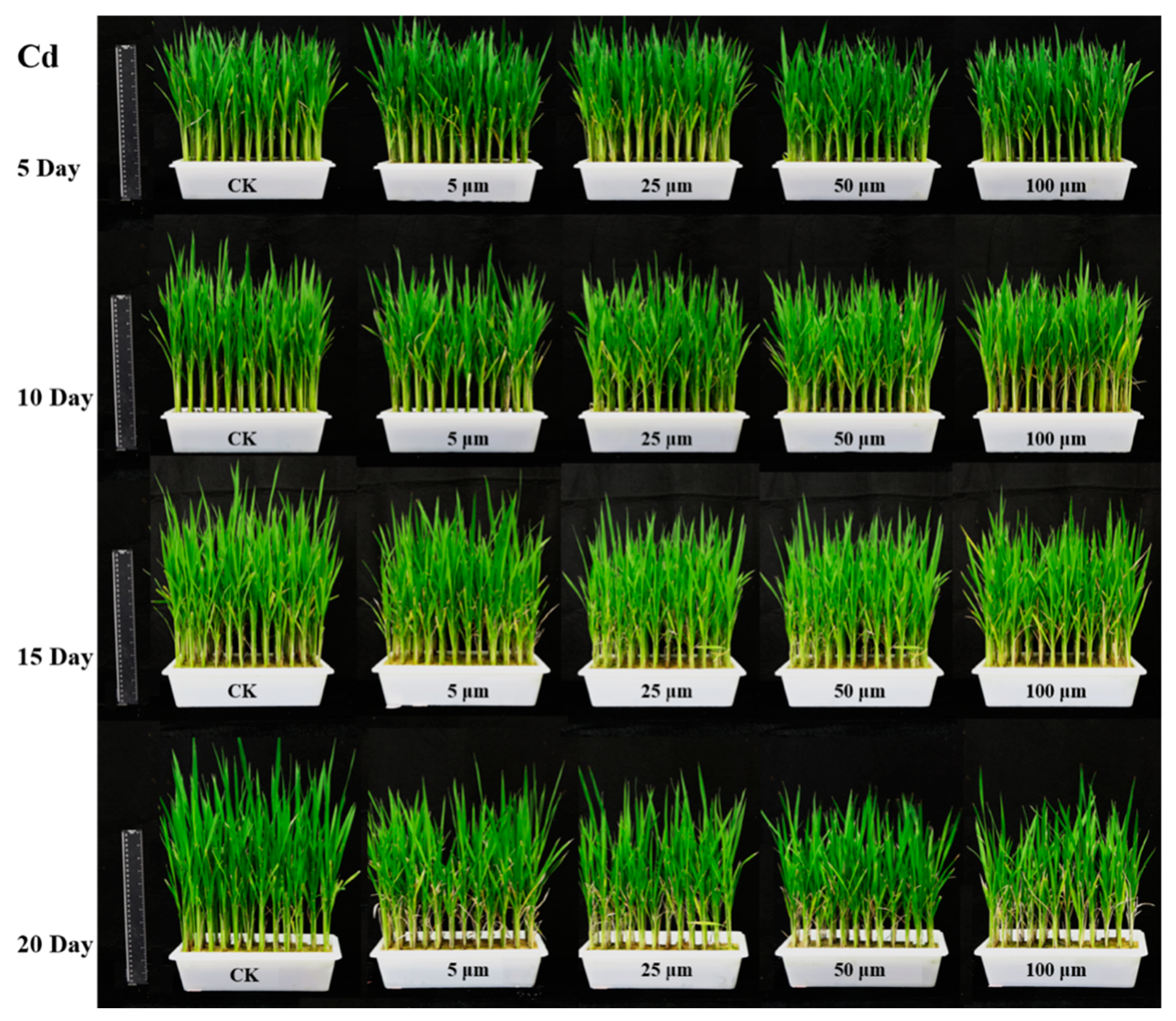
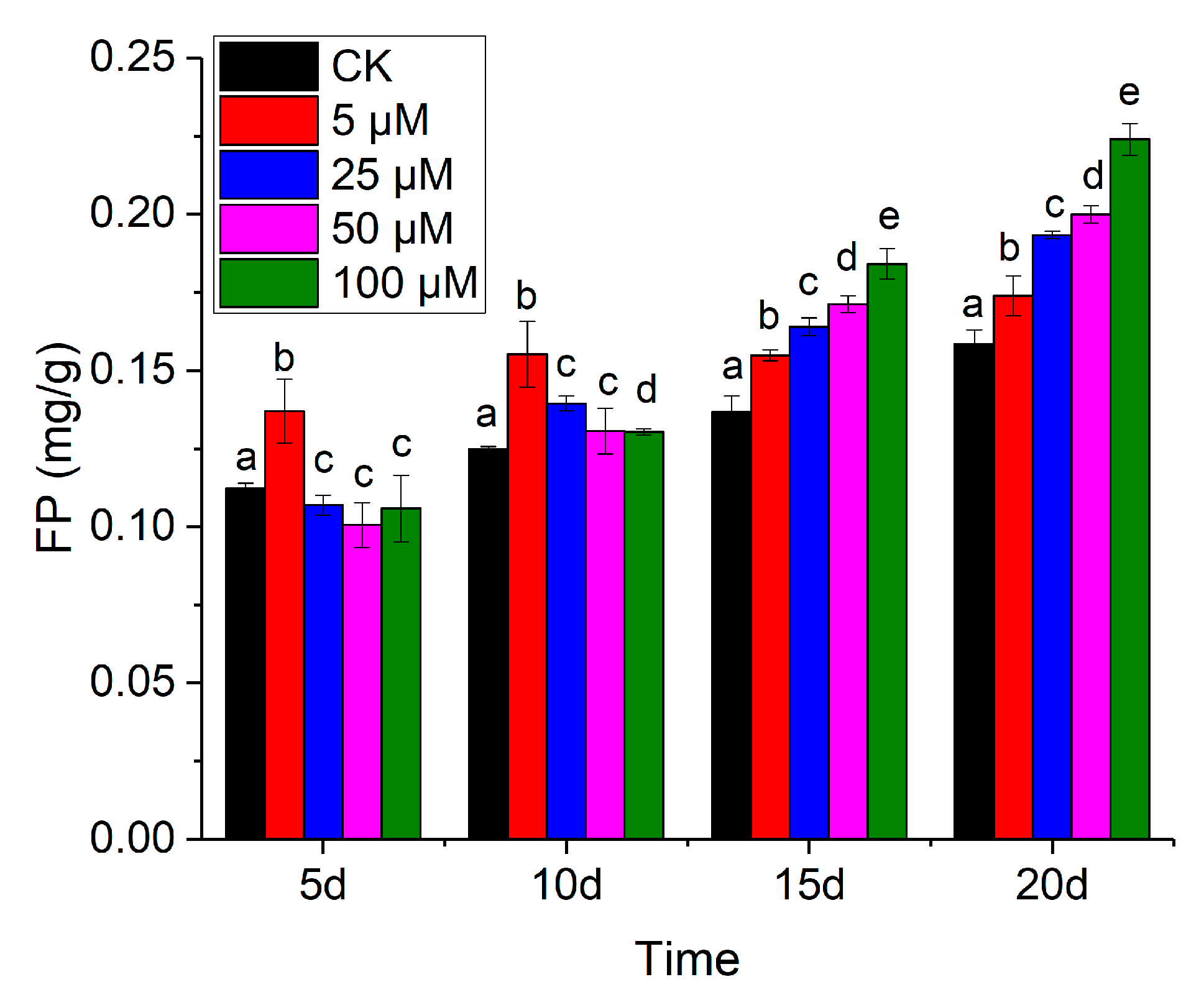
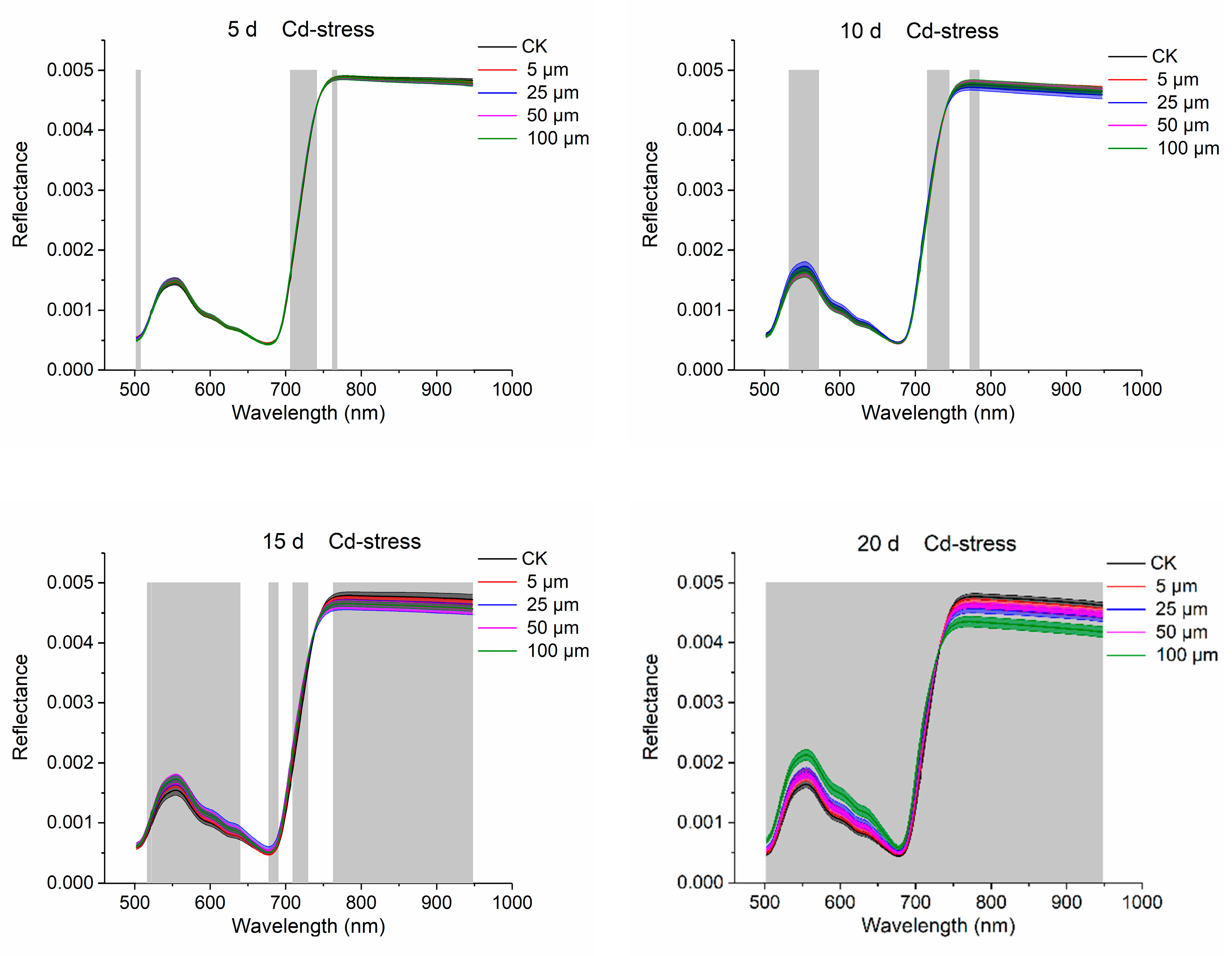
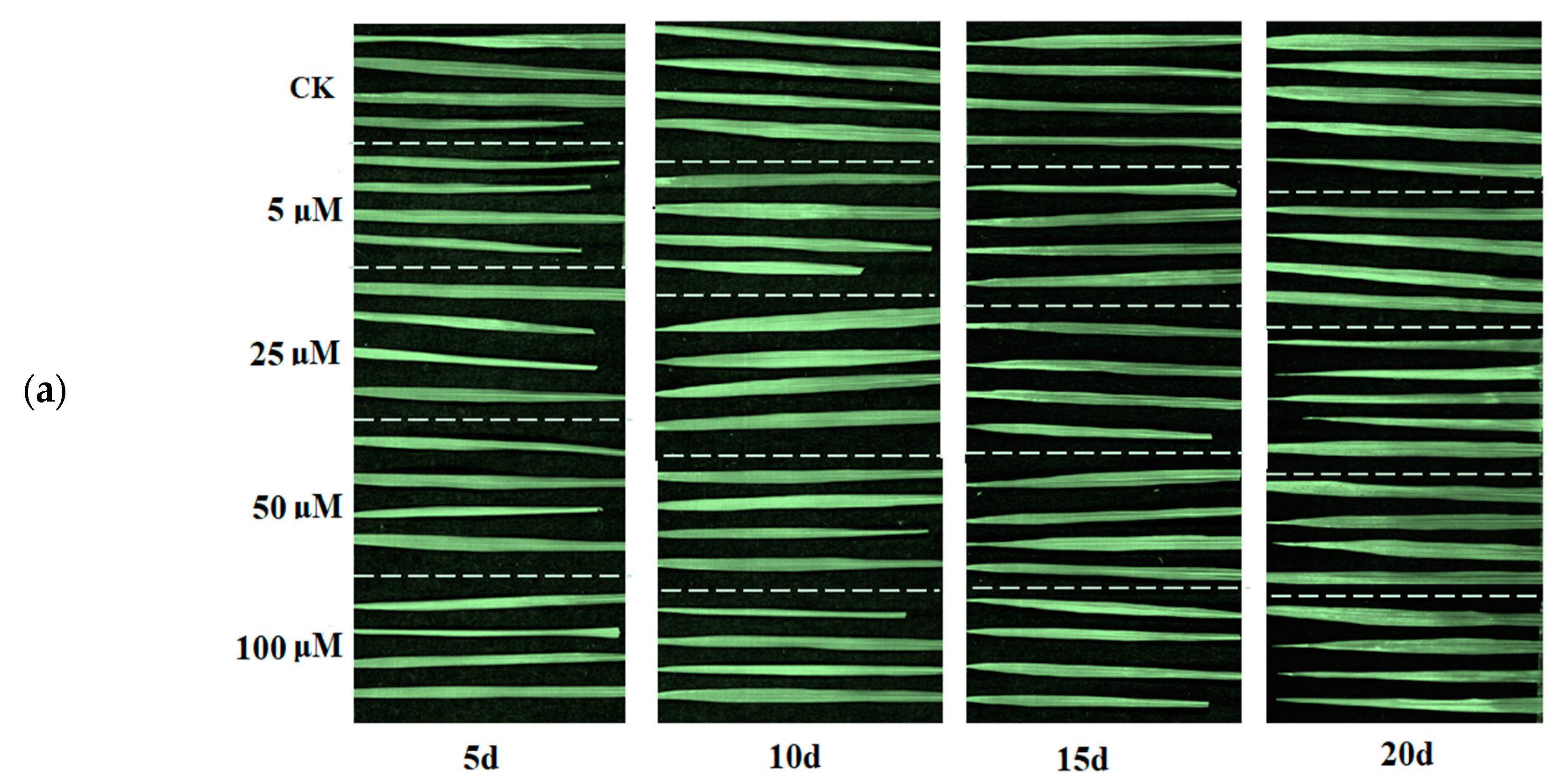
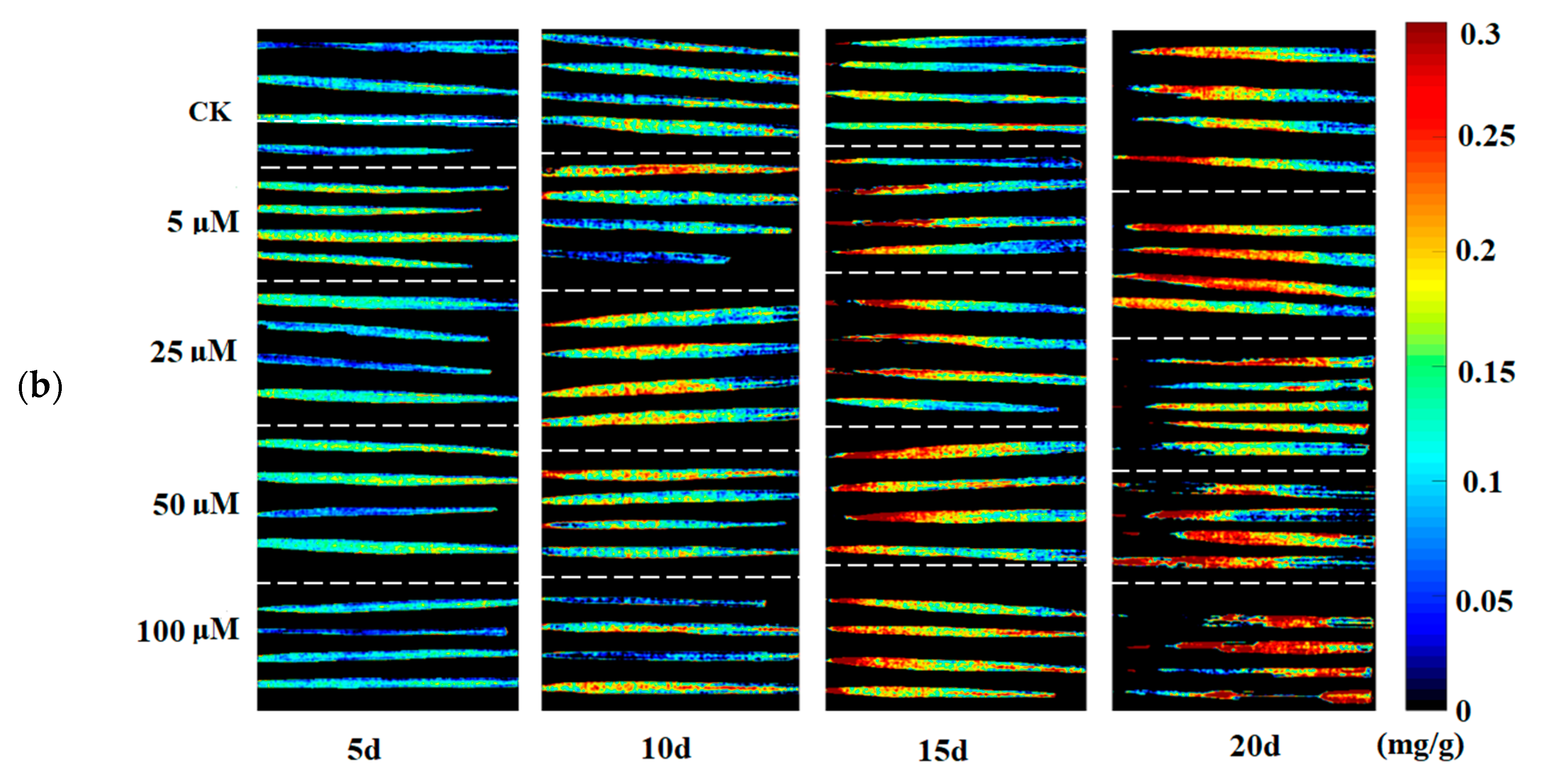
| Indicators | Groups | 5 d | 10 d | 15 d | 20 d |
|---|---|---|---|---|---|
| FP | Number | 25 | 25 | 25 | 25 |
| Min | 0.0740 | 0.1170 | 0.1304 | 0.1401 | |
| Max | 0.1359 | 0.1479 | 0.1795 | 0.2186 | |
| Mean | 0.1027 | 0.1335 | 0.1622 | 0.1880 | |
| S.D. | 0.0172 | 0.0096 | 0.0138 | 0.0192 |
| Models | Parameter 1 | Rc | RMSECV (mg/g) | Rp | RMSEP (mg/g) |
|---|---|---|---|---|---|
| PLS | 9 | 0.8915 | 0.0015 | 0.8830 | 0.0191 |
| LS-SVM | 246,566.22; 30,674.42 | 0.9292 | 0.0123 | 0.8541 | 0.0215 |
| ELM | 38 | 0.9435 | 0.0109 | 0.9190 | 0.0161 |
| Ways | Number | Models | Parameter 1 | Rc | RMSECV (mg/g) | Rp | RMSEP (mg/g) |
|---|---|---|---|---|---|---|---|
| GA | 29 | PLS | 11 | 0.8686 | 0.0164 | 0.8725 | 0.0199 |
| LS-SVM | 1,168,705.8; 6596.5 | 0.9131 | 0.0135 | 0.8498 | 0.0214 | ||
| ELM | 28 | 0.9388 | 0.0114 | 0.9219 | 0.0166 | ||
| CARS | 27 | PLS | 9 | 0.8850 | 0.0154 | 0.8905 | 0.1840 |
| LS-SVM | 661,182.0; 1889.8 | 0.9356 | 0.0117 | 0.8590 | 0.0214 | ||
| ELM | 24 | 0.9401 | 0.0112 | 0.9426 | 0.0135 | ||
| Bw | 14 | PLS | 7 | 0.8959 | 0.0147 | 0.8765 | 0.0196 |
| LS-SVM | 2,430,985.3; 4068.6 | 0.9370 | 0.0116 | 0.8574 | 0.0213 | ||
| ELM | 19 | 0.9352 | 0.0117 | 0.8995 | 0.0178 |
© 2020 by the authors. Licensee MDPI, Basel, Switzerland. This article is an open access article distributed under the terms and conditions of the Creative Commons Attribution (CC BY) license (http://creativecommons.org/licenses/by/4.0/).
Share and Cite
Shen, T.; Zhang, C.; Liu, F.; Wang, W.; Lu, Y.; Chen, R.; He, Y. High-Throughput Screening of Free Proline Content in Rice Leaf under Cadmium Stress Using Hyperspectral Imaging with Chemometrics. Sensors 2020, 20, 3229. https://doi.org/10.3390/s20113229
Shen T, Zhang C, Liu F, Wang W, Lu Y, Chen R, He Y. High-Throughput Screening of Free Proline Content in Rice Leaf under Cadmium Stress Using Hyperspectral Imaging with Chemometrics. Sensors. 2020; 20(11):3229. https://doi.org/10.3390/s20113229
Chicago/Turabian StyleShen, Tingting, Chu Zhang, Fei Liu, Wei Wang, Yi Lu, Rongqin Chen, and Yong He. 2020. "High-Throughput Screening of Free Proline Content in Rice Leaf under Cadmium Stress Using Hyperspectral Imaging with Chemometrics" Sensors 20, no. 11: 3229. https://doi.org/10.3390/s20113229
APA StyleShen, T., Zhang, C., Liu, F., Wang, W., Lu, Y., Chen, R., & He, Y. (2020). High-Throughput Screening of Free Proline Content in Rice Leaf under Cadmium Stress Using Hyperspectral Imaging with Chemometrics. Sensors, 20(11), 3229. https://doi.org/10.3390/s20113229







